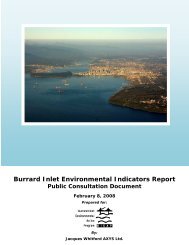Best Practices for the Reduction of Air Emissions From Construction ...
Best Practices for the Reduction of Air Emissions From Construction ...
Best Practices for the Reduction of Air Emissions From Construction ...
You also want an ePaper? Increase the reach of your titles
YUMPU automatically turns print PDFs into web optimized ePapers that Google loves.
CHEMINFO<br />
Keeping <strong>the</strong> spray gun clean maintains <strong>the</strong> gun’s<br />
efficiency and reduces <strong>the</strong> risk <strong>of</strong> poor results due to<br />
clogged tips or passages or <strong>for</strong>eign matter<br />
contamination. Proper and regular maintenance <strong>of</strong><br />
spray guns will also serve to mitigate VOC<br />
emissions. The following practices should be adhered<br />
to:<br />
• Clean <strong>the</strong> spray gun regularly to ensure optimum<br />
atomization and spray pattern;<br />
• Clean equipment as specified by <strong>the</strong><br />
manufacturer; and<br />
• Disassemble and inspect spray guns regularly.<br />
Ano<strong>the</strong>r cleaning practice where VOC emissions can<br />
be reduced through special equipment is line<br />
cleaning. One method that can improve line cleaning<br />
efficiency is to introduce turbulence into <strong>the</strong> solvent<br />
going through <strong>the</strong> line during cleaning. Equipment<br />
that <strong>for</strong>ces alternating pulses <strong>of</strong> solvent and<br />
compressed air is one way to accomplish this.<br />
In addition, lines should never be cleaned by<br />
spraying VOCs into <strong>the</strong> air or into filters. Clean-up<br />
solvents should always be directed using minimal<br />
pressure into containers. Solvents should be drawn<br />
from a closed supply solvent container and<br />
discharged into a closed container with an opening<br />
only large enough to accommodate <strong>the</strong> tip <strong>of</strong> a spray<br />
gun. In addition, <strong>the</strong> spray gun pressure should be<br />
lowered (decreasing air and paint pressure) to<br />
minimize atomization <strong>of</strong> <strong>the</strong> solvent during cleaning.<br />
7.4.1.9 Alternative Coating Application<br />
Techniques Should be Used<br />
Where feasible, rollers or brushes should be used<br />
instead <strong>of</strong> spray guns in order to reduce <strong>the</strong> quantity<br />
<strong>of</strong> solvent-based paint thinners that are required. In<br />
addition, transfer efficiency <strong>for</strong> direct application<br />
methods (i.e., rollers, brushes) can approach 100%.<br />
7.4.1.10 Alternative Cleaners or Low-VOC<br />
Cleaners Should be Used Instead <strong>of</strong> Solvents<br />
Where possible, non-VOC or low-VOC cleaning<br />
agents should be used instead <strong>of</strong> solvents. For surface<br />
preparation as well as clean-up operations,<br />
alternative cleaning agents to solvents (e.g., aqueous<br />
surfactant solutions) should be used.<br />
7.4.1.11 Solvents Used <strong>for</strong> Cleaning Should be<br />
Minimized<br />
When cleaning products containing VOCs are used,<br />
<strong>the</strong> following work practices should be applied in<br />
order to reduce <strong>the</strong> amount that has to be used:<br />
• Solvents with a low vapour pressure (flash point<br />
greater than 60°C) should be used. The use <strong>of</strong><br />
common mineral spirits that typically have a<br />
40°C flash point should be avoided;<br />
• A standard should be established to assure that<br />
used solvent is disposed <strong>of</strong> or recycled only when<br />
it loses its cleaning effectiveness, not just<br />
because it looks dirty;<br />
• The amount <strong>of</strong> cleaning agent to be used should<br />
be minimized by blowing as much old paint as<br />
possible back through <strong>the</strong> lines with compressed<br />
air (or by scraping <strong>the</strong> paint <strong>of</strong>f <strong>the</strong> surface);<br />
• Pre-determined and measured amounts <strong>of</strong><br />
solvent should be used (i.e., know how much is<br />
to be used be<strong>for</strong>ehand);<br />
• When soaking is required, containers with air<br />
tight lids should be used;<br />
• Used solvents should be returned to sealed<br />
containers <strong>of</strong> a waste collection system <strong>for</strong><br />
recycling and re-use;<br />
• Cleaners should be contained (i.e., covered) and<br />
tightly sealed) whenever feasible in order to<br />
reduce evaporative losses.<br />
• Solvent-soaked rags should be disposed <strong>of</strong> in a<br />
covered container;<br />
• Segregate cleanup solvents and recover/reuse<br />
<strong>the</strong>m;<br />
• Self-closing funnels on barrels and hoses <strong>for</strong><br />
solvent transfer should be used;<br />
• The spray gun should be emptied <strong>of</strong> paint prior<br />
to cleaning so that <strong>the</strong> gun system is completely<br />
dry; and<br />
• Equipment should be cleaned promptly after use<br />
in order to prevent <strong>the</strong> drying <strong>of</strong> coatings and<br />
consequently <strong>the</strong> need to use additional solvents<br />
in <strong>the</strong> cleaning operation.<br />
7.4.1.12 Paint Colour Changes Should be<br />
Optimized to Reduce <strong>the</strong> Use <strong>of</strong> Cleaning Solvents<br />
The amount <strong>of</strong> cleaning with solvents can be reduced<br />
through various strategic operating practices, <strong>for</strong><br />
instance:<br />
<strong>Best</strong> <strong>Practices</strong> <strong>for</strong> <strong>the</strong> <strong>Reduction</strong> <strong>of</strong> <strong>Air</strong> <strong>Emissions</strong> <strong>From</strong> <strong>Construction</strong> and Demolition Activities 36
















